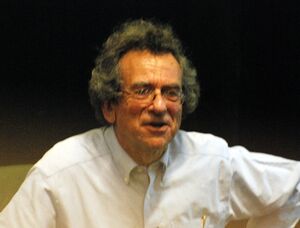Biography:N. David Mermin
N. David Mermin | |
|---|---|
 N. David Mermin | |
| Born | 30 March 1935 (age 90) New Haven, Connecticut, U.S. |
| Alma mater | Harvard University |
| Known for | Mermin–Wagner theorem Mermin–Ho relation Lindhard–Mermin dielectric function Coining the term 'boojum' Mermin–Peres magic square |
| Awards | Lilienfeld Prize (1989) National Academy of Sciences (1991) Klopsteg Memorial Award (1994) Majorana Prize (2010) American Philosophical Society (2015) Vision 97 Award (2017)[1] |
| Scientific career | |
| Fields | Physicist |
| Institutions | Cornell University University of California, San Diego University of Birmingham |
Nathaniel David Mermin (/ˈmɜːrmɪn/; born 1935) is a solid-state physicist at Cornell University best known for the eponymous Mermin–Wagner theorem, his application of the term "boojum" to superfluidity, his textbook with Neil Ashcroft on solid-state physics, and for contributions to the foundations of quantum mechanics and quantum information science.[2]
Mermin was the first to note how the three-particle GHZ state demonstrates that no local hidden variable theory can explain quantum correlations.[3][4] Together with Asher Peres, he introduced the "magic square" illustration of quantum contextuality,[5] and he coined the phrase "shut up and calculate!" to characterize the views of many physicists regarding the interpretation of quantum mechanics.[6] Starting in 2012, he has advocated the interpretation known as Quantum Bayesianism, or QBism.[7][8]
In 2003, the journal Foundations of Physics published a bibliography of Mermin’s writing that included three books, 125 technical articles, 18 pedagogical articles, 21 general articles, 34 book reviews, and 24 "Reference Frame" articles from Physics Today.[9]
Mermin's foot
Mermin has contributed to special relativity with two books and several articles. In It's About Time (2005) he suggests that the English foot (0.3048 meters) be slightly modified:
- Henceforth, by 1 foot we shall mean the distance light travels in a nanosecond. A foot, if you will, is a light nanosecond (and a nanosecond, even more nicely, can be viewed as a light foot). …If it offends you to redefine the foot … then you may define 0.299792458 meters to be 1 phoot, and think "phoot" (conveniently evocative of the Greek φωτος, "light") whenever you read "foot".[10]
This adaptation of a physical unit is one of several ploys that Mermin uses to draw students into space-time geometry.
Books
- 1968: Space and Time in Special Relativity, McGraw Hill ISBN:0-88133-420-0
- 1976: (with Neil Ashcroft) Solid State Physics, Holt, Rinehart and Winston ISBN:0-03-083993-9
- 1990: Boojums All the Way Through, Cambridge University Press ISBN:0-521-38880-5
- 2005: It's About Time: Understanding Einstein's Relativity, Princeton University Press ISBN:978-0-691-12201-4
- 2007: Quantum Computer Science, Cambridge University Press ISBN:978-0-521-87658-2
- 2016: Why Quark Rhymes with Pork, and Other Scientific Diversions, Cambridge University Press ISBN:978-1-107-02430-4
References
- ↑ His acceptance speech can be read at Mermin, N. David (2017-10-14). "Mysl, smysl, svet". arXiv:1710.05229.
- ↑ "Letters from the Past - A PRL Retrospective" (in en-US). Physical Review Letters. 2014-02-12. https://journals.aps.org/prl/50years/milestones.
- ↑ Caves, Carlton M.; Fuchs, Christopher A.; Schack, Rüdiger (2002-08-20). "Unknown quantum states: The quantum de Finetti representation". Journal of Mathematical Physics 43 (9): 4537–4559. doi:10.1063/1.1494475. ISSN 0022-2488. Bibcode: 2002JMP....43.4537C. http://aip.scitation.org/doi/10.1063/1.1494475. "Mermin was the first to point out the interesting properties of this three-system state, following the lead of D. M. Greenberger, M. Horne, and A. Zeilinger, “Going beyond Bell’s Theorem,” in Bell’s Theorem, Quantum Theory and Conceptions of the Universe, edited by M. Kafatos (Kluwer, Dordrecht, 1989), p. 69, where a similar four-system state was proposed.".
- ↑ Mermin, N. David (1990-08-01). "Quantum mysteries revisited". American Journal of Physics 58 (8): 731–734. doi:10.1119/1.16503. ISSN 0002-9505. Bibcode: 1990AmJPh..58..731M. http://aapt.scitation.org/doi/10.1119/1.16503.
- ↑ Mermin, N. David (1993). "Hidden variables and the two theorems of John Bell". Reviews of Modern Physics 65: 803–815. doi:10.1103/RevModPhys.65.803. Bibcode: 1993RvMP...65..803M.
- ↑ N. David Mermin. "Could Feynman Have Said This?". Physics Today 57 (5). doi:10.1063/1.1768652. Bibcode: 2004PhT....57e..10M.
- ↑ Mermin, N. David (2012-07-01). "Commentary: Quantum mechanics: Fixing the shifty split". Physics Today 65 (7): 8–10. doi:10.1063/pt.3.1618. ISSN 0031-9228. Bibcode: 2012PhT....65g...8M. http://physicstoday.scitation.org/doi/10.1063/PT.3.1618.
- ↑ Mermin, N. David (2014-03-27). "Physics: QBism puts the scientist back into science" (in en). Nature 507 (7493): 421–423. doi:10.1038/507421a. http://www.nature.com/doifinder/10.1038/507421a.
- ↑ "Publications of N. David Mermin" (in en). Foundations of Physics 33 (12): 1797–1809. 2003-12-01. doi:10.1023/A:1026233805919. ISSN 0015-9018. https://link.springer.com/article/10.1023/A:1026233805919.
- ↑ It's About Time, page 22
Further reading
- Daniel Greenberger and Abner Shimony (2003) "The Presence of David Mermin", Foundations of Physics 33(10) doi:10.1023/A:1026033228750
- Abner Shimony (2003) "Four Poems dedicated to David Mermin", Foundations of Physics 33(11) doi:10.1023/A:1026069319123
External links

